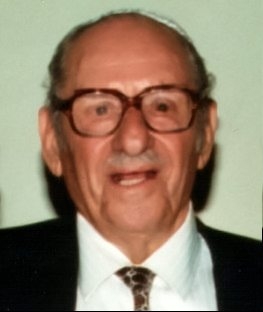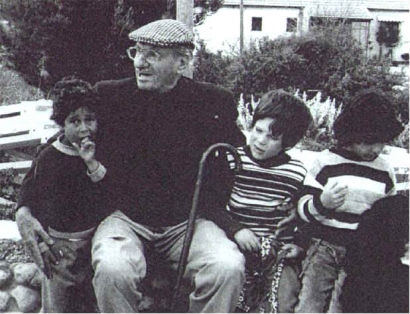Home > Oasis of Peace > Community > People pages > In memory of Wellesley Aron
In memory of Wellesley Aron
2001

Wellesley Aron (1901 - 1988)
Early NSWAS member Wellesley (Pinchas) Aron, a graduate of Cambridge University, emigrated to Palestine in 1926. Three years later, the late Dr. Chaim Weizmann (Israel’s first president) called him back to London to serve as his political secretary. There, in London, Wellesley Aron conceived and created the Habonim Movement to provide Jewish youth with a knowledge of their history and traditions and with the definite aim of eventually participating in the growth of what was then called "The Jewish National Land". Based on the International Scout Movement, Wellesley produced the first handbook and guidelines of a movement which was to spread quickly throught he Jewish population in the UK and South Africa and, in a rather different form, in the USA. After he had seen Habonim well-estabilsihed, he returned to Palestine where he led an extraordinarily interesting and varied life until, in 1979, he became a member of NSWAS, where he lived until his death in 1988.

Wellesley (Pinchas) Aron’s Path to Neve Shalom Wahat al-Salam
I NEED AN ADDRESS ...
"... My grandson tells me he doesn’t want to go to a war academy and learn war, he wants to go to a peace academy and learn peace. Can anyone, please, give me the address of a peace academy?"
The late Wellesley (Pinchas) Aron put this question to a meeting of Rotary International in Jerusalem, in 1967. Their inability to provide such an address led the distinguished assembly to request Wellesley to "find out what is ’being done about peace’ in the world". For ten years he relentlessly pursued this quest, following every lead wherever it took him across Europe and the USA. At the end of that time he was uncharacteristically depressed, dejected by his findings that nowhere in the world was anything "being done about peace" and particularly obsessed by the fact that in no school, college or university had he found "peace" on the curriculum as a subject for tuition. It was this which brought Wellesley to dedicate himself to the pursuit for motivation towards universal peace, and started him on the path which would lead him eventually to Neve Shalom/Wahat al-Salam.
Ever the man of action he decided to find out whether, in fact, it was possible to teach peace as a subject. He went about it in the only way he knew how — by conducting his own experiment, in 1977, in a Tel Aviv high school, with the consent of the Ministry of Education. After two years of working intensively with a group of pupils who volunteered to go along with him, he knew that he had in his hand the key to teaching peace as a subject; and it was at this point that Dame Fortune turned a benign eye in his direction and brought him into contact with the small group of dedicated young people who were working on the embryonic idea of creating a School for Peace in an isolated fold of the Judean Hills which they called Neve Shalom - conceived originally as an ecumenical community by Father Bruno Hussar, who passed away in 1996.
It took very little time for Wellesley to decide that these were the people with whom he wanted to spend the rest of his life, this was the work he was destined to do, and this was the place in which the peace academy for which he had been searching would be built. He asked to be included in the budding project - a request which was accepted. Apart from his own charismatic self, he brought with him the extensive recording of his experiments and experiences during the two years of practical studies in the teaching of peace which he had just completed in the high school. And he encouraged this small group of young people to have big ideas.
During the fifty years Wellesley had already lived in Israel, he had served many aspects of the State - in the social and business fields, army service and in many covert diplomatic missions. There were few people in the highest echelons who did not know him and he was on warm and personal terms with many of them. He took full advantage of this to solicit high-level and prestigious support for the aims and ideology of co-existence being formed by this new community, as well as to obtain some infrastructure services which government departments were not willing to authorize. In addition, he had no compunction about approaching wealthy friends and acquaintances whose financial assistance in the early days was very significant. He had no hesitation in pulling the many strings he had in his hand and they compacted into the solid foundation on which Neve Shalom/Wahat al-Salam began to rise.
The validity of his foresight was brought home forcefully when the BBC made a video tape recording a workshop which took place in April 1994 in NS/WAS. The workshop was under the guidance of Professor Dan Bar-On of the Ben Gurion University of the Negev. Entitled "Children of the Third Reich" it brought together children of survivors of the Holocaust with children of the Nazi leaders. All, of course, were mature adults. It was evident that this intensely moving and sensitive meeting had been planned to take place in an atmosphere conducive to the participants, where they could feel free to express their deepest emotions. Without prior consultation, the BBC had understood the value of this community and, in the credits of their film, expressed thanks to "The Neve Shalom Peace Center".
Unsolicited, Neve Shalom/Wahat al-Salam had been accorded the title which Wellesley unshakably believed would be internationally recognized. He never doubted that eventually, rising from this community, will be a peace academy to counterbalance all the war academies in the world.
Wellesley worked untiringly from his small home in NS/WAS, from 1979 until his death in 1988, to espouse the ideals in which he believed - the most significant of which was that education is the central theme for all efforts towards peace. His concept was that "Peace" should be taught as a subject in all schools - all over the world - from a very early age. In those days this was a revolutionary idea.
It was not given to him to live to see his prophecy fulfilled, but he did see the first model plan for the development of the community on which is clearly defined the area allocated to the Neve Shalom/Wahat al-Salam Peace Campus. C.A.




